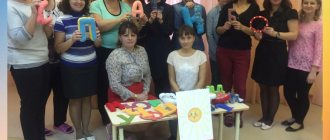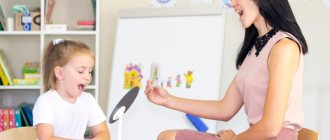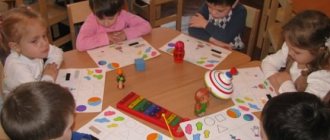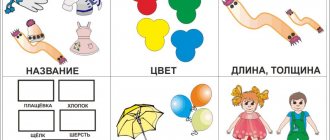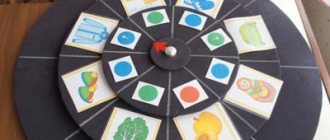Speech therapy games made by teachers and educators are aimed at developing breathing abilities and include articulation exercises and games with air. To form a syllable structure, a variety of activities are used to reinforce the skill of dividing words into syllables. Various variations in the formation of the basic phonemes of the Russian language. Many exercises using visual material are devoted to the development of the articulatory apparatus.
The games proposed below were developed by preschool teachers and speech therapists and are used to increase work efficiency and diversify the material used in the correctional process.
Game aids and material for speech therapy sessions
Contained in sections:
- The work of a speech therapist. Speech therapy 8289
Includes sections:
- Differentiation, automation of sounds. Didactic games 385
- Breathing exercises. Homemade games and manuals 437
- Speech development. Speech games, teaching aids 3320
- Tongue. Speech therapy visual and didactic aids 13
By groups:
- Senior group
- Preparatory group
- Middle group
- Junior group
Showing publications 1-10 of 1421. All sections | Speech therapy games
New
Photo
The best
Summary of a speech therapy lesson in the junior group “Toys” Lesson 1 Topic: “Toys (acquaintance)
» Objectives: 1. Clarify and expand the vocabulary on the topic.
2. Form a generalizing concept of “toy”
.
3. Learn to build a phrase from 2 words. 4. Develop attention and memory. 5. Develop the ability to listen to the words therapist , follow simple instructions, carefully...
Didactic game “Logocube”
The didactic game “ Logocube ”, for children of senior preschool age, develops phonetic-phonemic concepts, the syllabic structure of words , forms the lexical-grammatical structure of speech, coherent speech and cognitive processes.
Option No. 1 “Identify the first sound.” Target:…
Game “Make words”.
Target. Practice making three-letter words.
Equipment . Gymnastic hoops, two sets of numbers “1”, “2”, “3”.
Sets of letters (the first set: “K”, “O”, “T”, “D”, “Y”, “M”, from which the words “cat”, “smoke” are made; the second set of letters: “S”, “O”, “K”, “D”, “O”, “M”, from which the words “juice”, “house” are made; the third set of letters: “W”, “A”, “R”, “L” ", "U", "H", from which the words "ball", "ray" are made).
Carrying out the game. The teacher tells the children that today they will play words, each child will be a letter, and the letters have their own places in the hoops, where the number “one” will be the first letter, where “two” will be the second, where “three” - third. Then the children are divided into two teams. Two sets of three hoops are placed in front of them. The teacher puts the numbers “1”, “2”, “3” into each set. The teacher gives the children letters and says what words each team makes.
Children say a rhyme:
One-two, one-two,
We make up words.
Then each child must stand in their place and hold up their letter.
The team that completes the word first wins.
You can play the same game with more complex words.
Speech therapy games - 14 speech therapy games to prepare for school
Publication “14 speech therapy games to prepare for...” Remembering what certain letters look like, in what order they should be in order to turn abracadabra into a word, and much more - all this must be mastered by the child before school. And so as not to get bored, it is better to do it in the form of a game Before learning to read consciously and...
Image library "MAAM-pictures"
Summary of the game on "Geocaching" in the senior speech therapy group "Travel to the country of Zdoroveykino" Summary of the game on "Geocaching" in the senior speech therapy group. Topic: “Travel to the country of Zdoroveykino!” Goal: to form in children an idea of a healthy lifestyle; strengthen the basic components of health, create a desire to engage in physical activity. The assignments help...
Experimental games in speech therapy classes One of the fundamental principles of the Federal State Educational Standard of preschool education is the formation of the child’s cognitive interests and cognitive actions in various types of activities. It is through cognition that children develop in preschool age. Kids are very inquisitive...
Summary of a speech therapy lesson on the lexical topic “Toys” Lexical topic “Toys”. Sounds [g], [g'], [k], [k'] Lesson 1 Correctional and educational purposes. Clarification and expansion of ideas about toys, their purpose, details and parts of which they consist; the materials from which they are made. Clarification and activation of the dictionary on...
Speech therapy games - Scenario of the speech therapy quest game “Vegetables and Fruits”
Article “Scenario of the speech therapy quest game “Vegetables and...”
“Vegetables and fruits” Speech therapy quest game. Goal: to consolidate children’s knowledge about vegetables and fruits. Objectives: Educational: - to strengthen children’s ability to classify objects on the topic “Vegetables and fruits”; — to introduce children to a healthy lifestyle. Create an idea that...
Mid-term project “The role of speech therapy games and aids as a means of automation and differentiation of sounds” “The child has a passion for play, and it must be satisfied. We must not only give him time to play, but we must imbue his entire life with this game. His whole life is a game” A. S. Makarenko Project for speech therapy children from the senior and preparatory groups (5-7 years old. Developed by:...
Using the methodological guide “Froebel's Gifts” in the work of a speech therapist A teacher always wants to share something good and useful with colleagues. “The new is the well-forgotten old!” - says an old well-known saying, and this is not accidental. I bring to your attention the “Gifts of Froebel” sets. The developer of this set is Friedrich Wilhelm...
Summary of speech therapy lesson “Wild Animals” using interactive materials
Not all speech therapy rooms are technically equipped, and mine was one of them. But a few years ago, a TV appeared in my office, which now serves as a screen, and I can freely not only show the children educational videos and presentations, but also...
Pages: … 143
Classes with a speech therapist
The development of a child’s speech in preschool age occurs quickly and is interconnected with the level of intellectual development. The main foundation of speech development occurs before 3 years of age. The child quickly expands his passive and then active vocabulary, the sound design of words is enriched, and the first phrases and sentences appear. The level of speech development of all children is different, some are able to correctly pronounce words, construct phrases and sentences by the age of three. Other children need help from an adult, a specialist. The speech of such children may not be clear, sound pronunciation or syllable structure may be impaired.
In such cases, preschool teachers, speech therapists and educators carry out speech therapy work using various auxiliary materials, books, games developed by leading specialists or speech therapists at a preschool institution.
MAGAZINE Preschooler.RF
Speech therapy didactic games.Authors:
- Solovyova Natalya Sergeevna teacher-defectologist MKDOU No. 5 “Cheburashka” Kirov region, Vyatskie Polyany
- Titova Snezhana Gennadievna teacher-speech therapist MKDOU No. 5 “Cheburashka” Kirov region, Vyatskie Polyany
- Ustinova Olga Nikolaevna teacher-defectologist MKDOU No. 2 “Firefly” Kirov region, Vyatskie Polyany
Didactic games are intended for individual and subgroup speech therapy sessions with children aged 4 – 7 years. This material will be useful to speech therapists, speech pathologists, educators, and parents.
Didactic game “Cat and Mouse”
for preschool children (3-7 years old).
Corrective tasks:
- Automate set sounds.
- Maintain emotional and positive comfort.
- Promote the development of children's communication and communication skills.
- Develop articulatory, fine and gross motor skills.
- Form correct breathing
Equipment: Board game from Fix Price “Chasing Cheese” , cards with pictures in the name of which there are sounds S, S', Z, Z', Ts, Ch, Shch, Sh, Zh, L, L, R, R', cards for articulation gymnastics, orange cards “Try, repeat” , “Focus” , “Do as I do” (Appendix 1), cube.
Game description: Number of players: 1-4 people. This game can be used both in individual lessons and in subgroups.
Progress of the game:
A child and an adult lay out cards on the playing field, place mice, ladders and a cat. Before the start of the game, a finger game “Mice are dancing” (Appendix 2). The mice are having fun on the cheese, and the cat is sleeping at this time. As the poem ends, the cat wakes up and the mice run away. The child takes the mouse and throws it into the hole. The mouse lands on a certain picture, the child completes the task indicated in this picture. If the child does it correctly, then he can remove the card and see how many pieces of cheese his mouse was able to drag away. Takes the same number of pieces of cheese from the jar.
- option. The cat goes back to sleep, and the mice climb onto the cheese again. Everything repeats itself again.
- option. The child throws the dice, and the mouse moves as many spaces as there are dots on the dice, and the game continues in a circle.
If the mouse lands on the orange “Focus” , then the child performs exercises to develop proper breathing. The teacher prepares these exercises in advance and at his own discretion. If the card is “Do as I do,” then the child performs finger exercises. And if “Try, repeat ,” then the child must reproduce the movement drawn on the card.
Goal: development of articulatory, general, fine motor skills and speech breathing.
Orange cards and cards for performing articulation exercises are laid out on the field.
Goal: automation of delivered sounds, development of general and fine motor skills, speech breathing.
Orange cards and cards with pictures are laid out on the field.
Didactic game “Speech therapy lotto”
for preschool children (4-7 years old).
Corrective tasks:
- Automation of delivered sounds.
- Development of articulatory, fine and general motor skills.
- Formation of correct breathing
- Sound differentiation
- Development of mental processes
Equipment: cards with pictures in the name of which there are sounds S, S', Z, Z', Ts, Ch, Shch, Sh, Zh, L, L, R, R', cards for articulation gymnastics, orange cards “ Try, repeat” , “ Focus” , “Do as I do” (Appendix 1), cube, playing field, small toys.
Description of the game: this game is intended for individual lessons with a child.
Pictures with a certain sound are laid out on the playing surface.
Tasks:
- "Find and name" . The child is given a set of cards with pictures and is asked to find the same ones on the playing field and name what is drawn on them.
- "What's under... " The teacher arranges small toys into pictures and invites the child to say in a sentence what is under a certain toy (the toys are selected in accordance with the given sound). For example, automating the C sound at the beginning of a word:
Under the dog, a bag. Under the elephant, juice. There is a pine tree under the owl.
3. "Couples" . The teacher lays out pictures (for a certain sound and orange cards) on two playing fields and places paired crayons on them. The child’s task is to find paired toys and name the pictures under them. If an orange card appears, the child must complete the corresponding task. Orange card:
“Focus” - exercises to develop correct breathing. The teacher prepares these exercises in advance and at his own discretion.
“Do as I do” - finger exercises.
“Try, repeat” - reproduce the movement drawn on the card.
4. Task with a cube. The child rolls the dice and moves his chip to the front exactly as many steps as the number of points on the dice and names the picture. Or completes the task of the orange card.
5. “What’s on the left, what’s on the right?” . The child composes a phrase using the words “left” and “right” .
6. "What's in between?" The child says in a chain: “Between the hedgehogs and the beetle is a toad.
7. "What's around?" . The child says in a chain: “Near the stick there is a wolf, near the wolf there is milk .
8. “What’s next?” Child: “Next to the hero is a matryoshka, next to the matryoshka is a sailor .
9. “Remember and repeat . The child names the objects in the pictures and tries to remember them. Then he closes his eyes. An adult turns over one picture. Opening his eyes, the child guesses it. Next, the adult closes all the pictures. And the child must remember and arrange the pictures on the second field, as in the first field.
10. “Say the word . An adult pronounces a word without saying the last part, which contains an automated sound.
11. "Square" . The adult gives the child the task: “Name the picture in the center, from the center - one cell up, one cell to the right, etc.” .
12. “Make a proposal . The child makes sentences from words in the same row horizontally, vertically and diagonally.
13. “Find a place” The child lays out pictures on the playing field in accordance with the location of the given sound.
14. Sound differentiation task. The teacher lays out pictures on two playing fields. The child needs to find and cover objects with the same sound with small toys.
Game "Building a house" .
for preschool children (4-7 years old).
Corrective tasks:
- Automate set sounds.
- Maintain emotional and positive comfort.
- Develop articulation and fine motor skills.
- Form correct breathing
Equipment: cubes of different colors with Velcro, cards (with Velcro) with pictures in the name of which contain the sounds S, S', Z, Z', Ts, Ch, Shch, Sh, Zh, L, L, R, R', cards for articulation gymnastics (with Velcro).
Game description: Number of players: 1-4 people. This game can be used both in individual lessons and in subgroups.
Progress of the game:
Option 1: The teacher attaches the necessary pictures to the cubes. Then he reads the text of the finger game and builds a house out of cubes, while the child makes movements with his hands to the text of the game. When the house is built, the child names the objects in the pictures or performs appropriate articulation exercises.
- Assignments: “Name who lives in the red apartment” , “What is in the green apartment” . “Name the residents of the first floor” , “Name the residents of the first floor of the yellow apartment” . “Who lives next to, under, to the right, to the left, above, above, below .
- Assignment: Make a proposal.
- Task: “Find an apartment N, W, W, etc.” (all residents of the apartment have a certain sound in their names).
- Option: The child rolls the dice, names the pictures (or does an articulation exercise) and builds a house. Then he makes up a sentence using the pictures on the cubes.
| Next > |
